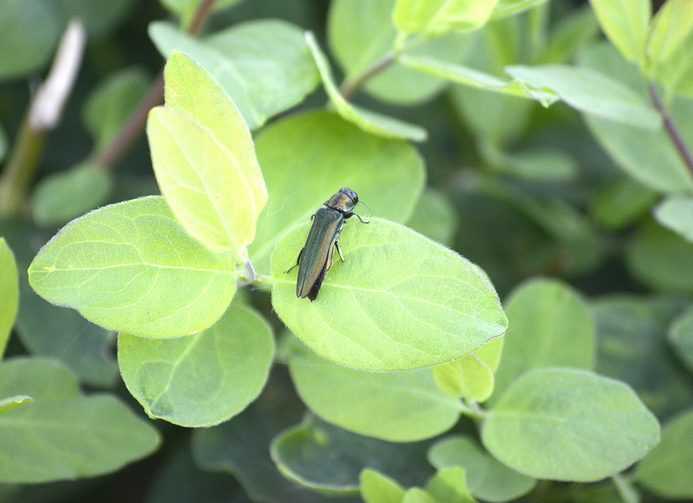As a homeowner, the trees in your yard may not occupy as much of your attention as your house or lawn. But certain insects put the health of your trees at risk. Protect them by learning about emerald ash borers, bark beetles, and the damage each species can cause to your property.
Emerald Ash Borer
The emerald ash borer may be eye-catching with its brilliant green body and red abdomen, but it’s an invasive species in the United States. Measuring just over ½ inch long, its physique is sometimes accented with copper hues and is capped by serrated antennae. Despite emerald ash borers’ unique appearance, these brightly colored bugs usually go unnoticed as they wreak havoc on ash trees.
Emerald Ash Borer Damage
So, how does the emerald ash borer kill trees? Adults feed on leaves, and females deposit their eggs on and under tree bark. Tiny larvae feed off the bark and create galleries deep inside the tree trunk to protect themselves from the cold. Multiple generations of emerald ash borer larvae sap enough nutrients to kill a tree. Signs of emerald ash borer damage are:
- Exit holes
- Deformed bark
- Notches on leaves
- Sprouts on the trunk
- Leaves falling from the treetop
- Zigzags or “S” shapes beneath the bark
- Pieces of bark on the ground around the tree
If used safely, insecticides can shield a tree from emerald ash borers and their larvae. Contact PURCOR for safe, effective treatments.
Where did the emerald ash borer come from?
These unintentionally destructive pests are originally from Asia. Emerald ash borers are thought to have stowed away to the United States in packing materials. The first emerald ash borer in the United States was first identified in Canton, MI, a community near Detroit. This insect doesn’t harm trees in its native Asia, but emerald ash borer damage has been found in trees around the U.S.
Bark Beetle
Another invasive beetle species is bark beetles. The bark beetle has a small, cylinder-shaped body with a hard exterior. Its body is oval-shaped and about the size of a grain of rice. Bark beetle larvae are white with dark heads and look like most other grubs.
Bark Beetle Damage
Bark beetles tend to live in sick or dying trees, where they reproduce beneath the bark. Like emerald ash borers, bark beetles tunnel under bark and devour nutrients from the trunk that would normally help the tree grow and thrive.
There are 600 types of bark beetles, which puts many kinds of trees in danger. However, they seem to target fir, pine, cedar, and spruce trees most often. Other tree types that can suffer from bark beetle damage include:
- Elm
- Fruit
- Larch
- Cypress
- Redwood
Holes in the trunk and dark or fallen leaves are indicators of bark beetle damage.
How to Send Bark Beetles Packing
As with emerald ash borer damage, professional, environmentally-friendly solutions are key to eliminating bark beetles from your trees. Contact PURCOR for beetle control services. You can also prevent future damage by watering trees regularly and watching them for unusual markings or signs of damage.
PURCOR can help mitigate and prevent emerald ash borer and bark beetle damage. Whether you’ve spotted signs of pest damage or want to take a proactive approach to prevention, get in touch with us today. We provide these and other pest control services in Idaho, Oregon, and Washington.
Our friendly, knowledgeable technicians can help restore and protect the natural beauty of your trees. Request your free quote or schedule a service appointment online. You’ll help protect your own trees and prevent the spread of these pests to nearby forests.
"*" indicates required fields
"*" indicates required fields




